| Posted: Aug 06, 2015 |
Anomalous magnetic structure and spin dynamics in magnetoelectric LiFePO4
(Nanowerk News) A team at Helmholtz-Zentrum Berlin für Materialien und Energie (HZB) has recently unraveled intricate details of the magnetic structure and dynamics of the magnetoelectric compound LiFePO4. Such materials currently find use in sensors but there are promising perspectives for magnetoelectrics to be applied in data storage and spintronic devices as well.
|
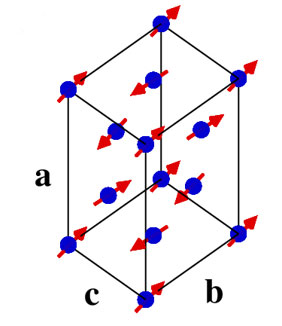 |
| The magnetic structure of LiFePO4.
|
|
Through a series of neutron scattering experiments at the BER II neutron source, HZB scientists found a new excitation branch in the material and signs of a non-collinear magnetic structure. This structure was shown to produce a magnetoelectric response through the so-called Dzyaloshinsky-Moriya interaction – a magnetic interaction originating in the atomic spin-orbit interaction. The modelled temperature dependence of the magneto-electric response is in good agreement with experiment.
|
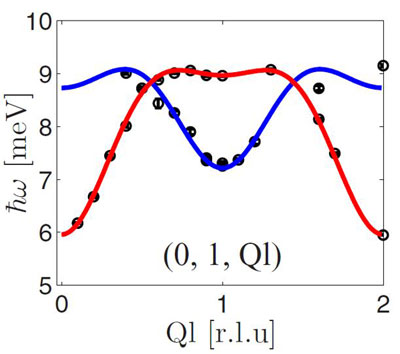 |
| The magnetic excitations of LiFePO4 as measured on the recently upgraded cold neutron triple axis spectrometer FLEXX. Two model dispersion branches were fitted to the data—a high-intensity one (red line) and a low-intensity one (blue line).
|
|
The results were published in Physical Review B ("Anomalous magnetic structure and spin dynamics in magnetoelectric LiFePO4").
|
|
In magnetoelectric materials, magnetization and electric polarization are coupled in the sense that applied magnetic fields can induce an electric polarization and vice versa. Such materials currently find use in sensors but there are promising perspectives for magnetoelectrics to be applied in data storage and spintronic devices as well. The coupling between magnetization and electric polarization arises when minor details of the crystal structure have a huge impact on the magnetic interactions and hence the magnetic structure.
|
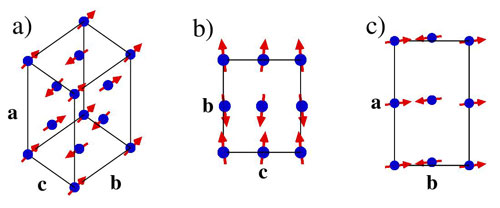 |
| The magnetic structure of LiFePO4 (a) and the projections onto the bc plane (b) and ab plane (c), respectively. The magnetic moments are canted, both, relative to each other and relative to the crystallographic axes.
|
|
LiFePO4, a model system for this class of materials, has been investigated by the HZB researchers who have now identified a minor canting of the magnetic moments to be the driving mechanism behind magnetoelectricity in this compound.
|
|
A canted magnetic structure
|
|
Using the triple axis spectrometer V2/FLEXX at the BER II neutron source, the magnetic excitations of antiferromagnetic LiFePO4 were measured along different crystallographic axes than previously (Fig. 1). Two branches in the excitation spectrum revealed a complex set of magnetic interactions and a large magnetic anisotropy. Strong magnetic anisotropy is usually a consequence of a significant spin-orbit contribution to the magnetic ground state. |
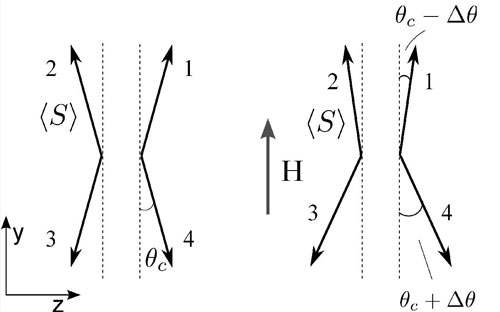 |
| The magnetic structure in fields applied along b. The small field-induced difference in canting angle between the two spin pairs (1,2) and (3,4) is evident.
|
|
The significance of the spin-orbit coupling was confirmed when examining the magnetic structure in detail on the E5 diffractometer. Here, weak magnetic peaks revealed a magnetic structure where the magnetic moments are not entirely parallel but slightly canted towards each other (Fig. 2). Such canting can be caused by the spin-orbit induced Dzyaloshinsky-Moriya (DM) interaction that prefers magnetic moments to be perpendicular instead of parallel.
|
|
Modelling the magneto-electric response
|
|
This DM interaction is very sensitive to the symmetry of the crystal structure. Inducing an electric polarization with a magnetic field implies a movement of ionic charges inside the crystal, and therefore a lowering of the symmetry of the crystal structure. When applying a magnetic field on a canted magnetic structure, the canting angles and therefore also the DM energy will change (Fig. 3).
|
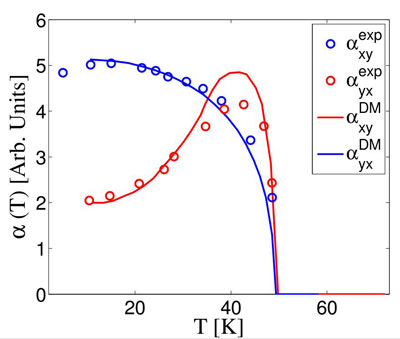 |
| The calculated temperature dependence of the magnetoelectric coefficients αxy and αyx (lines) compared to experimental data from the literature (symbols). The excellent agreement confirms the anticipated model based on the Dzyaloshinsky-Moriya interaction as inferred from the neutron scattering data.
|
|
The HZB team was able to show that LiFePO4 could adapt to this change by displacing the oxygen ions of the crystal and allowing DM interactions otherwise forbidden due to the crystal symmetry. Using this model, they calculated a temperature dependence of the magnetoelectric coefficients αxy and αyx which are the constants describing the linear relation between the magnetic field and the electric polarization. The calculated magnetoelectric coefficients have been found in good agreement with earlier experiments (Fig. 4) confirming that the anticipated model applies.
|





